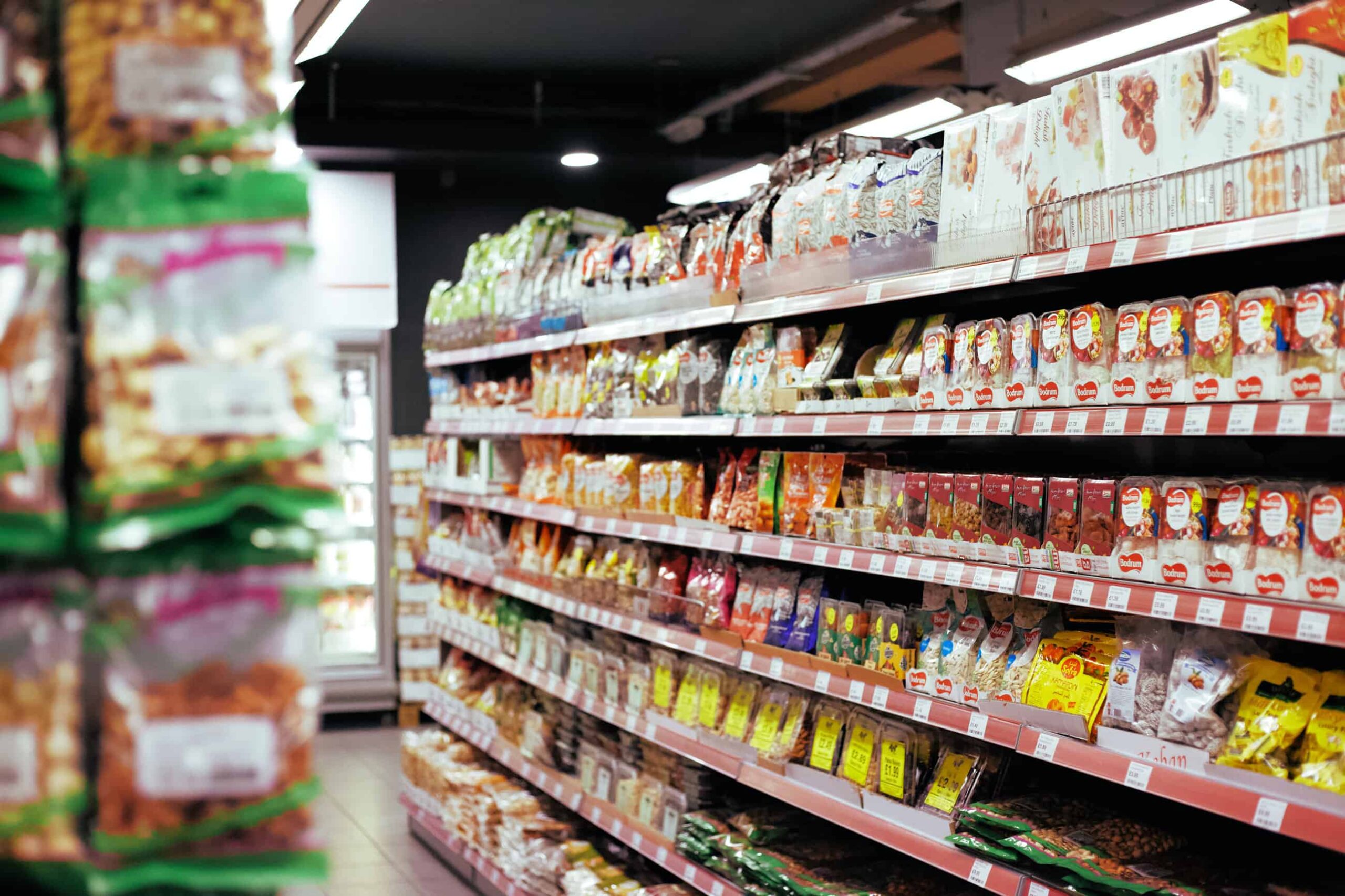Product Distribution 101: Get Your Product in Stores
If you’ve got a great product, the next step is product distribution to get your product sold in stores. Here’s what you need to know.

When you’ve gone through the process to create a product you’re proud of, you want it sold far and wide to reach as many customers as possible. But how do you get your product in stores? Mike Harrington, a sales trainer for Boston Beer Company, shared his team’s strategies for product distribution.
In this article, we will provide you with information on product distribution, best practices, examples, and easy-to-access resources that relate to initiating, building, and maintaining distributor relationships.
What Is a Product Distributor?
A product distributor—or wholesaler—is a company that sells products to retail businesses. As a business owner that sells and manufactures products—or supplier—you can sell your product in bulk at a contract price to the distributor. Then the distributor sells your product at wholesale pricing to retailers.
3 Types of Product Distributors
1. National:
National distributors have relationships with key retailers or “national accounts” as it’s known in the business. These are major retailers like Whole Foods or Walmart—large retailers that are found all over the country. They can leverage these relationships to get your product into mass distribution. They can do this quickly and on a large scale.
While larger distributors are going to have the ability to quickly increase your product’s distribution, they aren’t going to spend as much time getting your product into smaller, regional or local chains. They also aren’t going to spend as much time talking about and selling your specific product, since they need to spread their time and attention across the vast array of products they sell.
2. Regional: Regional wholesalers and distributors don’t have quite as big of a geographical footprint. They also probably have less brand recognition and overall pull as compared to national distributors. But regional distributors are more engaged with their suppliers, and therefore have more time to devote to you and your supplier partners to continue working on growing the brand.
3. Local or Specialty: These distributors are great for specific retail accounts. They are often more expensive and have stricter guidelines as it relates to distribution. The areas they sell to are smaller, and they sell fewer products. In some cases, there may be opportunities for more profitability because they are so specialized.
The smaller distributors may have more time to dedicate to you and your product, but they aren’t going to have the ability to distribute your product as widely as a large wholesaler.
Advantages to Working With a Product Distributor
Distributors are pretty complex organizations and there are some nuances you should know before working with them. First, we will explore the advantages of working with a product distributor. There are three main reasons why you want to consider working with a product distributor:
1. Wider Distribution: This allows you to get your product to the widest possible audience. When working with the right distributor, you can quickly expand your business’s footprint.
2. Provides Resources: Provides third-party sales, delivery, and infrastructure capability to your business. Your sales and delivery force might be a small team, so you can see how a distributor could help.
3. Saves Time: Creates more supplier bandwidth to invest time in product development and manufacturing. You can invest time back into yourself, your brand, your product, and your company because the distributor is handling the sales capability and infrastructure that have probably saddled you since your business has grown.
The Disadvantages of Working With a Product Distributor
Of course, before signing on the dotted line, there are a few things you should consider about the cons of working with a product distributor.
Negative Impact on Profit Margins: You probably have an idea for how much you’d like to sell your product for at retail, and what your profit margins are. You’ll have to take that into consideration when trying to figure out what price to sell your product to a distributor for, and then the distributor will sell your product to retailers. The con: working with a product distributor will negatively impact margins on product sales.
Someone Else Tells Your Brand Story: You’ll have to rely on a third party to “tell the story” of your product as well as you do or your direct sales team would. Ultimately, no one is more passionate about your business than you are or your direct sales team. Therefore, it’s critical upfront that you train the salesforce of the distributor and show them that passion so that they have the tools to tell your story. It’s your job to get them as excited as you are to sell your product. Come prepared with materials to make it easier to sell your product and to know where they should sell it.
Difficult to Gain Traction: When it comes to distributors, many of them are already working with a large number of products. It can be difficult to generate and maintain “share of mind” or product popularity when a product is young, not established, and with no proven track record. It’s important to be consistent in pursuing sales channels with distributors to try to develop consumer awareness.
Whether you choose to work with a product distributor or not depends on your long-term vision for your business, and where you plan to be in several years. If a distributor makes sense in fulfilling those plans, then it’s best to get started with a distributor early on.
Frequently Asked Questions About Product Distributors
1. How do I know when my business is ready for a distributor?
When there is warranted volume and profit opportunity, as well as a corresponding increased need for:
- Inventory Housing
- Sales Staff
- Trucking and Delivery
Knowing when you’re ready for a distributor comes down to questions of capacity. To what degree do I have the ability to produce a certain quantity of my product? Then based on the sales rate of my product, how many retail outlets do I want to sell my product to? Once you understand the volume and profit opportunity for your product, that’s when it makes sense to consider a distributor.
There are some other factors to consider when evaluating your need for a 3rd party distributor:
- Your business plan: How many or how much of your product are you looking to produce? How many customers are you planning to sell to?
- Customer service: You (the supplier) can no longer adequately service your existing customer base due to time constraints.
- Capacity: Sales projections out-pace current production levels.
- Delivery Services: The cost of product servicing and delivery to the supplier begins to seriously affect sales and profits.
2. What questions can I expect from a distributor? What information can I prepare when I begin working with a distributor?
Before you can start building relationships with distributors, you need to have a plan.
What is your plan? You can’t build sales support materials until you have a clear picture of what you want to accomplish and how you’re going to do it. Most suppliers come up with an annual plan that explains the following:
- Distribution opportunity and targets: These are the retail outlets not selling your product that could be.
- Target category and demographics: This enables the distributor to work with you collaboratively to identify the direct opportunities for your product.
- Suggested pricing and wholesaler margin: You need to consider your margins, the distributor’s margins, as well as the retailers’ margins.
- Available supplier resources: These are resources you might bring to the table, such as financial support like salesforce incentives; manpower such as sales reps you can leverage to help the distributor; advertising on radio or TV; the point of sale (POS), etc.
- Market insights and positioning: Where will the product live? What does it add to the category? What value or advantage does it bring to the wholesaler? Is my product an improved version of an existing product that brings an advantage to the wholesaler and adds something new to the retail space? Perhaps it’s a completely new product that creates its own category.
Ultimately, you must be prepared to answer these questions from the wholesaler:
- What is the reason/value for the distributor to PLACE the product? What angle can they use to sell your product to retailers?
- What is the reason/value for the consumer to PULL the product off the shelf or out of the cooler, or wherever the product is placed in retail stores?
- In other words, what differentiates your product from other similar products? Some reasons might be quality, profitability, and value to the customer.
3. How should I approach a conversation about increasing my distribution?
Distributors sometimes look at “How can we increase distribution?” as an adversarial question, but they shouldn’t. Increased distribution is good for everyone’s bottom line. However, distributors have a lot of products to sell, and it’s up to you as the supplier to show them the opportunities that you see and make it very clear.
You can only effectively communicate solutions to buyers who see a gap that your proposed solution or product will fill. If the distributor is underperforming vs. your plan, the supplier’s responsibility is to illustrate the GAP: “This is where we are. This is where we could be. This is what we stand to gain. This is what we stand to lose.”
If the distributor is overperforming vs. your plan, it is STILL the supplier’s responsibility to illustrate the GAP: “We’ve achieved the goal, but demand is such that we have the opportunity to increase distribution, volume and profits. We are doing well, but this is how we’re performing vs. the competition or competitive distributor.”
The way you illustrate the gap is via market insights. This depends on your and the sales force’s ability to survey the market by gathering data on accounts that either carry or don’t carry your product and use that data to boost the selling story you’re presenting to the wholesaler. Success stories will sell your product. It helps greatly if you have a success story about how you worked with a retailer and you can pass that story on to the distributor’s sales force.
Increasing distribution depends on increasing share of mind—product and brand awareness—with distributors. To help your sales force increase share of mind, you can use product launch presentations to show exactly what the brand is and how to sell it. Provide selling tools to make their job easier and give them a selling story that makes it easy to recite to the retailers. Consistent products and valuing quality certainly helps, as well as providing field support to the distributor.
4. Are there any standard requirements that distributors have? For instance, do I have to be producing at a certain volume or speed?
The short answer is no, not necessarily. The distributor needs to see three things:
- The immediate profit potential of selling your product.
- The product is worth the time and effort necessary to sell it.
- That housing the product in their inventory will lead to increased sales and profits. They want to know there is value in the space that your product takes up in their warehouse.
5. Are there any resources that help me find distributors or choose between them?
There is no single go-to resource for finding and selecting a distributor. You can ask for referrals from other business owners in similar categories, attend trade shows, and ask retail buyers about their preferred distributor and why. You can learn a lot about walking into a retailer, examining the products on their shelves, and having a conversation with their buyer about their preferred distributors in a certain local geography. They will probably have a lot of insight into why one distributor works better than another.
Become a student of the industry from the above but also read journals and industry blogs to stay on top of the trends.
Lastly, if you have an attractive product and proposal, understand that you possess leverage. You do NOT need to enter a relationship with the first distributor that makes an offer. Make multiple proposals and evaluate which distributors’ offers are most attractive.
Conclusion
It’s important to understand the advantages and disadvantages of distributors. Know your business plan, where you are, and where you’re going in business. If you see your business expanding, it’s probably beneficial to partner with a distributor to get there. Be prepared and do your homework. Selling your product is not just about distribution, but about product and brand awareness or share of mind.





